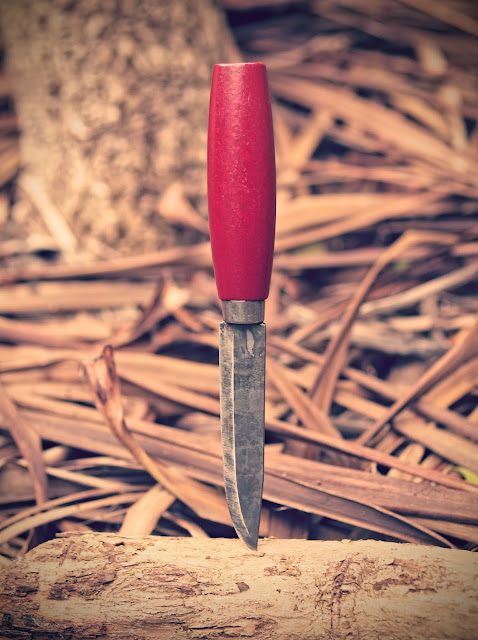 |
| Morakniv Classic No.2 |
Morakniv have been making knives for over 400 years. They're very popular with lots of bushcrafters around the world for various reasons. Mora knives are high quality for the price point. They're cheap and they're built to last. They're often recommended to beginners, but that doesn't mean that more experienced bushcrafters do not use these knives, they do. All Morakniv knives are made in Sweden.
 |
| Birch handle |
The Mora classic No.2 is a traditional Swedish carpenters and woodworkers knife. It is practically a "Puukko" style knife, which is popular across all the Nordic countries. The knife is balanced perfectly with a rat tail tang, which makes it perfect for delicate work that is often required in bushcraft. The birch handle is barrel shaped and comfortable in the hand. If you have big hands, you will not be disappointed with the handle of this knife. The steel is European C100 steel. This is a high carbon steel with the heat treat aimed towards high edge retention and strength. The blade is Scandinavian grind. These usually come with a micro bevel from the factory and are quite sharp. You can achieve a sharper edge with a little time spent on a whetstone and by removing the micro bevel, you'll achieve a extremely sharp edge.
 |
| Scandi grind with a clip point |
Morakniv Classic No.2 Specs:
Overall length: 250mm
Blade length: 105mm
Blade thickness: 2.5mm
Handle material: Birch
Blade Steel: C100 Carbon steel
Plastic Polymer Sheath
Overall the classic No.2 is a fantastic knife for bushcraft applications. First and foremost, this knife is not going to be suitable for heavy battening of wood; the knife is suitable for lighter bushcraft applications. The knife is perfect for fire preparation, shelter building, fishing, hunting and many other bushcraft practices. I've been using this knife for over a year now and have been impressed with the performance. The only modification I made is to the spine of the blade, this is rounded off at the factory and therefore does not throw sparks with a ferrocerium rod. I used a flat file on the spine to create a sharp edge, which now throws sparks with a ferrocerium rod perfectly. This is useful for fire preparation as well, as the spine can be used to create fine wood shavings for ignition.
 |
| Close-up of the scandi grind |
I recommend this knife to those that wish to have a traditional, Nordic knife that is of high quality, whilst being simple to maintain and care for.
 |
| Morakniv Classic No.2 |


Comments
Post a Comment